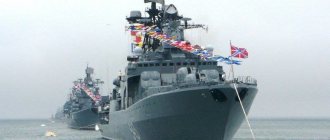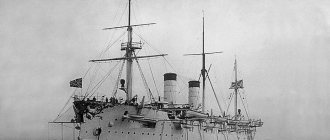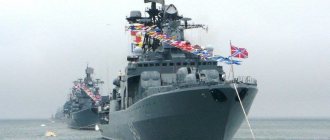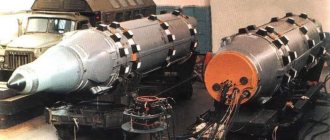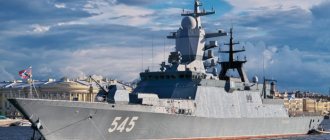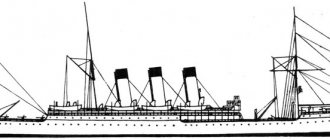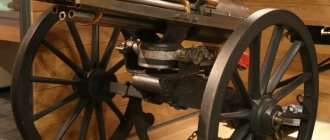USA
The history of the creation of US battle cruisers began well and... oddly enough, ended well, although it should be noted that there is no merit in this of American admirals and designers.
As a matter of fact, the idea of a battlecruiser was formulated in the USA back in 1903, when the Naval War College in Newport put forward the idea of an armored cruiser that had weapons and armor comparable to a squadron battleship, but exceeded the latter in speed. It was assumed that such ships should catch up and engage the enemy’s battleships in battle before the arrival of their main forces, so the cruisers should have been armed with 305-mm artillery and provided with protection against it. Such views clearly reflected the experience of the Spanish-American War, when US battleships could not keep up with the main forces of Admiral Cervera. At the same time, the success of the armored cruiser Brooklyn, which caught up and shot enemy ships, was largely explained not by the quality of its design, but by the inability of the Spanish gunners to hit the target. If the Spaniards had had training comparable to their American “colleagues”, then... no, in the Battle of Santiago de Cuba they would hardly have won in this case, but they could have severely damaged or even sunk the Brooklyn and saved both at least half of its armored squadron from destruction. Well, the American sailors should be given their due - the remarkable success at sea did not blind them, and did not overshadow the shortcomings of the material part of the US armored cruisers.
The conclusions of the Naval War College specialists could only be welcomed - the Americans initially saw the battlecruiser as a ship for participation in the battle of the main forces, their views turned out to be very close to the Germans, and it was the Germans who managed to create the most successful battlecruisers in the world in the period before the First World War . At the same time, the first US projects turned out to be, perhaps, even more advanced than their German counterparts.
While German shipbuilders and admirals achieved high speed of their battlecruisers by slightly weakening the protection and reducing the main caliber in comparison with the battleships being built at the same time, and for some time they could not decide on equal displacement of battleships and battlecruisers, in the USA there was nothing like that was. Their first battlecruiser project was an analogue of the Wyoming dreadnought (26,000 tons, 12*305 mm guns in six twin turrets, 280 mm armor and a speed of 20.5 knots).
Probably the most famous photo of the battleship Wyoming
But with a narrower and longer hull to achieve high speed, the length of the battlecruiser had to reach 200 m, which was 28.7 m longer than that of the Wyoming. The armament was weakened, but quite sufficient for combat with battleships - 8 * 305 mm guns in four turrets, and the speed should have reached 25.5 knots. At the same time, the reservation not only remained at the Wyoming level, but, perhaps, one could even say that it surpassed it. Although the thickness of the armor belt, decks, barbettes, etc. remained at the level of a battleship, but the length and height of the main armor belt should have exceeded those of the Wyoming. In this case, the displacement of the battlecruiser should have been 26,000 tons, that is, equal to the corresponding battleship.
Conceptually, the project turned out to be extremely successful for its time (the exact date of development is unknown to the author, but it was probably 1909-1910), but in those years in the United States they gave priority to the construction of dreadnoughts, so the “American Dreflinger” was never laid down. However, this project quickly became outdated, but not through the fault of its creators - the “305-mm” battleships were simply being replaced by the era of super-dreadnoughts...
The next project of the US battlecruiser, if it were embodied in metal, would definitely lay claim to the title of the best battlecruiser in the world - it was supposed to make it an analogue of the battleship Nevada, maintaining the latter's armor, but reducing the armament to 8 * 356 mm guns and providing the ship with speed at 29 knots. Taking into account the fact that the technical specifications for such a ship were presented back in 1911, and it was supposed to be laid down in 1912, such a battle cruiser would definitely leave all British, German and Japanese battle cruisers far behind.
Of course, such performance characteristics had to be paid for with something: the price was an increase in displacement over 30,000 tons (extremely large for those years), as well as a cruising range that was not the greatest by American standards - “only” 5,000 miles at economic speed. And if the Americans were ready to agree with the first (increase in displacement), the second turned out to be completely unacceptable to them. On the one hand, of course, you can blame the US admirals for this - for their European colleagues, a range of 5,000 miles looked more or less normal, but the Americans, even then eyeing Japan as a future adversary at sea, wanted to get ships with real ocean range and less than 8,000 miles did not agree.
As a result of the reasons stated above, several variants of the battlecruiser design were presented for consideration, in which, all other things being equal, the armor thickness was successively reduced from 356 mm to 280 and 203 mm, and only in the latter case a range of 8,000 miles was achieved. As a result, the American sailors preferred the latter option and... again shelved the matter, considering the construction of dreadnoughts a higher priority. However, it was here that, having made a choice in favor of cruising range due to a critical weakening of the armor, the Americans forever abandoned the projects of the best ships of this class for their time, to an amazing “something” called a Lexington-class battlecruiser .
The thing is that in 1915, when the American fleet again returned to the idea of building battlecruisers, the admirals completely changed their views on the role and place of this class of ships in the structure of the fleet. Interest in battlecruisers was fueled by the Battle of Dogger Bank, which demonstrated the potential of ships of this class, but it is surprising that the Americans have now adopted a new concept of a battlecruiser, completely different from either the British or the German. According to the plans of US admirals, battlecruisers were to become the backbone of “35-knot” formations, which also included light cruisers and destroyers capable of reaching the above speed.
Without a doubt, the technological level of that time made it possible to bring the speed of large ships closer to 35 knots, but, of course, only at the cost of huge sacrifices in other combat qualities. But for what? This is completely unclear, because any sane concept for using “35-node” connections has never been born. In general, the following happened: in an effort to achieve super speed of 35 knots, the Americans were not ready to sacrifice firepower and range: therefore, the armor and survivability of the battle cruiser had to be reduced to almost zero. The ship received 8*406 mm guns, but its hull was very long and narrow, which excluded any serious anti-tank protection, and the armor did not exceed 203 mm!
But something else is surprising. Already knowing that the British laid down the Hood and imagining its combat capabilities (the design documentation for the last British battlecruiser was transferred to the USA for review), and having received from the British an analysis of the damage to their ships received during the Battle of Jutland, the Americans stubbornly continued to cling to the British the concept of a battle cruiser - maximum speed and firepower with a minimum of protection. In essence, the US designers backed down on only one thing - realizing the insignificance of underwater protection, they increased the hull width to 31.7 m, providing a more or less decent PTZ for those years. The speed had to be reduced to 33.5 knots, but the ship remained extremely awkward - with a displacement of over 44,000 tons (about 3,000 tons more than the Hood!) and armament of 8 * 406 mm, its sides were protected by only 178 mm armor! The forehead of the towers reached 279 mm, the barbettes – 229 mm, the deckhouse – 305 mm. This level of armor was somewhat superior to the Repulse and Renaun before their modernizations, but, of course, was completely insufficient for action against any heavy ship in the world, and there is no doubt that the Lexington (this is how the series of American battle cruisers was named) were categorically inferior to Hood both in terms of protection and in the overall balance of the project. In general, the construction of six Lexington-class battlecruisers was completely unjustified by any tactical considerations, contradicted the world experience gained during the First World War, and would have been a huge mistake in American shipbuilding... if these ships had been completed for their original purpose.
Except that didn't happen. In essence, what happened was this: having learned the tactical and technical characteristics of post-war British and Japanese ships, the Americans realized that their newest battleships and battlecruisers, in general, were no longer at the peak of progress. Even more advanced and larger ships were required, but it was expensive, and besides, they would no longer be able to pass through the Panama Canal, and all this created huge problems even for the first economy in the world, which was the United States after the First World War. Therefore, US President W. Harding, who came to power in 1920, initiated a conference on the reduction of naval armaments, which became the famous Washington Naval Agreement, during which the United States, among other obligations, also abandoned the completion of six Lexingtons. At that time, the average technical readiness of the first and last American battlecruisers averaged about 30%.
In itself, the refusal to build huge and extremely expensive US battle cruisers, but completely inappropriate for the requirements of modern naval warfare, can already be considered a success, but that is not why we called the end of the Lexington story successful. As you know, two ships of this type were nevertheless introduced into the American Navy, but as ships of a completely different class - aircraft carriers. And, it must be said, “Lady Lex” and “Lady Sarah,” as the American sailors called the aircraft carriers Lexington and Saratoga, became, perhaps, the most successful aircraft carriers in the world, rebuilt from other large ships.
Demonstration of conversion of an aircraft carrier from a Lexington-class battlecruiser
This was facilitated by some design decisions that looked somewhat strange on battlecruisers, but were quite appropriate on aircraft carriers, which allowed some historians to even put forward the version that the Americans included in the project the possibility of such a restructuring at the design stage. According to the author of this article, such a version looks very doubtful, because at the design stage of the Lexington it was hardly possible to assume the success of the Washington Agreement, but this version cannot be completely denied. In general, this story is still waiting for its researchers, but we can only state that despite the completely absurd performance characteristics of Lexington-class battlecruisers, the history of the design of US battlecruisers led to the emergence of two remarkable, by pre-war standards, aircraft carriers.
Excellent couple: "Lady Lex" and "Lady Sarah"
For which we congratulate the US Navy.
Battlecruiser rivalry: Rinaun and Mackensen
As we already said in the previous article, according to the logic of things, the rivalry between battlecruisers should have ended on ships of the Tiger - Derflinger class. The British abandoned the further development of ships of this class and focused on high-speed battleships with 381 mm artillery, laying down five Queen Elizabeth-class battleships under the 1912 program (in fact, the laying took place in 1912-1913). Then it was the turn to replenish the main forces of the fleet with 381-mm battleships, and the program for the next year, 1913, included five Royal Sovereign-class battleships, reduced to 21 knots. speed. And then the time came for the 1914 program, according to which the British decided to lay down not five, but only four ships - three of the Royal Sovereign project and one of the Queen Elizabeth type. After the implementation of this program, the British fleet would have eight relatively slow-moving Royal Sovereigns and a high-speed vanguard of six Queen Elizabeths, while the total number of battleships with 381-mm guns would reach fourteen.
R-class battleships at sea
However, this did not happen: almost immediately after orders were issued for the construction of the specified four, which received the names “Rinaun”, “Repulse”, “Resistance” and “Egincourt”, the First World War broke out. Of course, in 1914, no one could have imagined the many-year nightmare into which Europe would be plunged - it was believed that the war would end in no more than six months to a year, and therefore the ships of the 1914 program could not make it in time, so their construction was frozen . But... not at the same time.
The fact is that “Resistance” and “Egincourt” were going to be built at the state-owned shipyards of Portsmouth and Devnoport, and with the outbreak of war, all preparations for their laying were interrupted immediately - the British wisely considered that they should concentrate on completing the construction of many different ships located in a high degree of readiness. But two other battleships of the Royal Sovereign class were ordered privately, built by Palmers in Greenock (near Newcastle), and Rynown by Fairfield in Gowan (Glasgow). And it was on these that the Admiralty did not stop work for some time, as a result of which the Repulse was nevertheless laid down, and several hundred tons of structural materials were prepared for the Rinaun. However, their construction soon slowed down due to the outflow of labor, and then was stopped altogether.
Let us recall that at this time the Minister of the Navy, or rather, as it was called in England, the First Lord of the Admiralty was Winston Spencer Churchill, while the First Sea Lord, Prince Louis of Battenberg, was in command of the Royal Navy. Soon after the start of the war, a hail of criticism fell upon him (not entirely justified), but it seems that the true reason for his resignation was that he bore a German surname, and was almost a purebred German. Accordingly, the post of First Sea Lord was vacant, and W. Churchill did not fail to remember his friend and teacher John “Jackie” Fisher. Despite the advanced age of seventy-three, the admiral still possessed completely indomitable energy and his return to the post he held until 1910 was politically acceptable.
Having again become First Sea Lord, D. Fisher developed the most vigorous activity, drawing the attention of the Admiralty to the lack of light ships - submarines, destroyers, etc. and all this was, of course, correct and useful. But D. Fisher experienced an incomprehensible, irrational love for the British-type battlecruisers, which he himself created - very fast and heavily armed ships with weakened armor. He was greatly upset by the Admiralty's refusal of battlecruisers, and now, having come to power again, he was eager to resume their construction. This was very difficult, since members of the British Parliament had long proclaimed that battlecruisers as a class of warships had completely outlived their usefulness and were no longer needed by the Royal Navy. But when did any difficulties stop John Arbuthnot Fisher?
Despite the fact that D. Fisher was distinguished by impetuosity and harshness of judgment, as well as intemperance that broke out more and more often, he remained an excellent politician and very subtly chose the moment for his proposal, but its essence boiled down to the following. D. Fisher proposed building two battlecruisers with a speed of 32 knots and the heaviest guns available (at that time we were obviously talking about 381-mm artillery), while the armor protection was supposed to remain at the Invincible level. Under normal conditions, such a proposal could not have been accepted, because there was no point in building such ships - they did not have a tactical niche that they could occupy. In other words, there was not a single task for which the fleet would require such ships. They were needed only by one person in all of Great Britain - John Arbuthnot Fisher himself. Even Sir Winston Churchill, who was openly prone to adventure, initially opposed them!
However, as we said above, the timing was simply perfect. First, the August raid of the British into Heligoland Bay, in which the support of Beatty’s five battle cruisers ensured the destruction of three German light cruisers and victory in the battle. It must be said that before the battle cruisers entered the battle, things were not going well for the British... Then came the defeat that struck England to the heart at Coronel, where the Scharnhorst and Gneisenau destroyed the main forces of Admiral Cradock’s squadron. And then - the triumph of "Invincible" and "Inflexible" in the Falklands, who destroyed the elusive and victorious detachment of Maximilian von Spee without losses and without serious damage to themselves. These events glorified the battlecruisers of England and seemed to confirm the correctness of their concept.
And so, immediately after the Battle of Falklands, John Fisher invites Winston Churchill to submit a proposal to resume the construction of battlecruisers for discussion by the Cabinet of Ministers. However, Sir Winston refused. He told his friend that these ships would divert resources needed for other, more important purposes, and still would not be ready until the end of the war. Well, D. Fisher immediately found other arguments.
Firstly, he stated that the ships would definitely make it to war, that last time he built the revolutionary Dreadnought in just a year and was undertaking to create the latest battle cruisers in the same period. Secondly, John Fisher drew the attention of W. Churchill to the fact that the battle cruiser Lützow, which will be able to develop at least 28 knots, will soon come into operation in Germany, while England does not have such ships. And finally, thirdly, the First Sea Lord pulled out a “trump card” - a plan for an amphibious operation in the Baltic Sea.
As you know, the idea of this operation was extremely extravagant - according to the general plan, the Royal Navy had to overcome the German defenses of the Skagerrak and Kattegat straits and invade the Baltic Sea, establishing its dominance there. After this, British ships would ensure the landing of British or Russian troops on the coast of Pomerania, that is, less than 200 km from Berlin itself. John Fisher argued that for such an operation the Royal Navy would need fast, heavily armed ships with a relatively shallow draft, which were not available.
The operation plan looked extremely attractive (on paper) and therefore D. Fisher’s proposals were accepted. Just 10 days after the Battle of Falklands, the English government approved the construction of two battlecruisers.
In fact, of course, all of D. Fischer’s arguments were not worth a damn. The battle in Heligoland Bight certainly confirmed the indisputable fact that giant ships with heavy guns, such as battlecruisers, are capable of destroying light cruisers, but so what? Battlecruisers were too large and expensive to combat enemy light ships. Of course, no one would deny the usefulness of using battle cruisers as cover for light forces, well, the British already had as many as ten ships of this class versus Germany’s five (if counted together with the Lützow)! Without a doubt, the battlecruisers proved their excellent counter-raider qualities, but the fact is that after the death of the Scharnhorst and Gneisenau, the Germans ran out of armored cruisers designed to operate in the ocean. “Fürst Bismarck” was completely outdated, the more or less modern “Blücher” was attached to the battlecruisers, and the rest of Germany’s armored cruisers were created as reconnaissance ships for linear squadrons and were not very well suited for ocean raiding. Of course, theoretically, there remained the possibility of sending them to the ocean, but to counter them, the British armored cruisers of the Warrior and Minotaur types, which were superior to the same Roon almost as much as the Invincible was superior to the Minotaur, would have been more than enough to counter them. Scharnhorst." And this is not to mention the fact that the British could always send a couple of battle cruisers of the Invincible and Indefatigable types to communications, and they would still have a numerical advantage over ships of the same class in Germany.
As for the “terrible” German “Lutzow”, the Royal Navy had at least one ship (“Tiger”) that was superior to it in speed, and the other three “343-mm” British battlecruisers, if inferior to it, it's quite insignificant. In any case, the Lutzow would have operated as part of a formation of battlecruisers, which would have neutralized its “superiority,” since any squadron is forced to rely on its slowest ship. And the need for a shallow-draft battle cruiser for operations in the Baltic Sea looks completely strange - why? In order to “drive” the enemy’s light forces, the battle cruiser is excessively large and powerful, and the enemy’s heavy ships will not enter shallow waters - besides, if we are to assume a battle with heavy ships in shallow waters, then what is needed is not speed, but armor protection. What else is it for? Landing fire support? So much cheaper monitors will cope with this task perfectly.
Even the most cursory analysis of such an operation led to the following - any attempt to break through the British fleet into the Baltic automatically led to a general battle between the German and English fleets - depending on the forces involved in the operation, the Germans would either approach the enemy from the sea, or transfer heavy ships to the Hochseeflotte Kiel Canal. Such an attempt by England would give the Germans what they dreamed of from the very beginning of the war - the opportunity to first wear out the main forces of the British fleet (in this case, during the latter's breakthrough of the minefields blocking the entrances to the Baltic), and then, when the forces were more or less equalize - give a general battle. Accordingly, for such an operation the British would have found a pair of standard battleships much more useful than weakly protected cruisers unable to fight in a line.
However, the drive and endless energy of D. Fischer did their job and he received permission to build. However, the First Sea Lord understood perfectly well that he had won only the first round - after all, the project of a new large warship had to go through the stages of various approvals, which could have killed this extravagant idea in every respect. But here the speed of construction he promised came to the aid of D. Fisher. In other words, he, under the guise of the need to start construction as soon as possible (and he promised to build battle cruisers in just 15 months!) had the opportunity to speed up the design procedure so much as to exclude from it as much as possible any approvals that would otherwise be mandatory.
As a matter of fact, the very first “technical assignment” that D. Fisher issued to the chief shipbuilder d’Eincourt suggests that the First Sea Lord perfectly understood the value of his “arguments” in favor of building battlecruisers. He demanded that d'Eyncourt design a ship like an improved Invincible with the heaviest main caliber artillery, a 102-mm anti-mine caliber, a speed of 32 knots, and one of the main requirements was the maximum height of the hull at the stem in order to provide the ship with the best seaworthiness . Actually, the project was called: “Ocean battle cruiser “Radamanthus””, and all that was said about the draft was: “reduce as much as possible.” As we see, as soon as we received the go-ahead for the construction of battlecruisers, the requirements for them for the Baltic operation seriously lost their relevance.
D'Eincourt tried to satisfy the wishes of the First Sea Lord as much as possible, and the very next day presented him with a sketch of the future ship - with a displacement of 18,750 tons and a speed of 32 knots, the battlecruiser had a 152 mm armored belt, a 32 mm deck and armament from two two-gun turrets 381- mm guns, as well as 20 102 mm guns. The battle cruiser turned out to be obviously weak, so D. Fischer, having familiarized himself with the project, ordered the addition of another 381-mm turret. This is exactly how the Rinauna project came about.
"Repulse." The date of the photo is unknown, but it is at least between the first and second world wars
It must be said that d'Eincourt did not like this battlecruiser, and he tried in every possible way to improve it, offering D. Fisher more protected options, but the First Sea Lord was inexorable. Then the shipbuilder went all-in and proposed installing another 381-mm turret - with such weapons, even a completely cardboard ship would still pose a serious danger to German battle cruisers. But nothing came of it here either, because only 6 turrets could be manufactured on time, but not 8, and D. Fisher left the new battlecruisers with three main-caliber turrets each and accelerated preparations for construction in every possible way. As a result, the ships were laid down just a little over a month after the start of design, on January 25, 1915 - the birthday of their “father,” John Arbuthnot Fisher.
Some publications indicate that Repulse and Renown are battleships of the Royal Sovereign type, completed according to a new design, but this is not so. As we said earlier, Fairfield also received orders for the construction of the battleships Repulse and Renown, respectively. But only Palmers managed to lay the ship; however, the company could not build a battle cruiser - it simply did not have a slipway of the required length. Therefore, the contract for the construction of the Repulse cruiser was transferred to the John Brown shipyard. All materials prepared that could be used in the construction of a ship of a new project were also transferred to it. Rinown was built by Fairfield, but, apparently, she was originally designed as a battlecruiser.
Artillery
As we have already said, the main caliber of the new British ships were 381-mm guns, similar to those installed on the battleships Queen Elizabeth and Royal Sovereign and representing a masterpiece of naval artillery. The only complaint about the Repulse and Rinaun was the lack of a fourth turret, since, having only 6 main caliber guns, the ships had difficulty shooting at long distances. But overall, the “big guns” of Repulse and Rinaun deserve the highest praise.
But the return to 102-mm mine artillery seems to be a clearly wrong step. Without a doubt, a four-inch projectile was significantly inferior in damaging effect to a six-inch one - it was assumed that one hit from the latter could disable a destroyer with a displacement of up to 1,000 tons. Only their quantity could compensate for the poor quality of 102-mm shells, in other words, it was necessary to ensure the maximum number of barrels in a salvo. But the number of single-gun 102-mm guns could not be increased indefinitely, and a solution was found in the creation of three-gun 102-mm installations. This theoretically ingenious solution, combined with a successful arrangement (out of five three-gun and two single-gun installations installed on each ship, four three-gun and one single-gun mounts could fire on one side) ensured that 13 guns could be fired on board - more than twice as many as battleships with a dozen 152 mm guns in casemates. However, the installations themselves turned out to be too heavy - having a weight of 17.5 tons, they were not equipped with power drives, so one could only sympathize with the gunners of these monsters.
102-mm Rinauna installation, 1931
But angular guidance speeds are very important for artillery firing at nimble and constantly changing course destroyers. In addition, a crew of 32 people was required to service each installation. Taking into account the fact that the crew of the 381-mm turret was 64 people, the total number of anti-mine artillery servants was almost equal to the crews of the main caliber guns.
The compact dimensions of the installation did not allow the crews to effectively service all three barrels (although each of them had its own cradle) - the gunners simply interfered with each other, so the real rate of fire of the three-gun installation was only slightly higher than that of the two-gun one. It is also worth noting the poor security of the crews - they stood completely open, having only shields, which, naturally, could not cover 32 people. All this together made the Repulse anti-mine artillery a nominee for the title of “worst anti-mine caliber of the Grand Fleet.”
The 102-mm artillery system provided a 10-kg projectile with an initial speed of 800 m/sec, which at an elevation angle of 30 degrees. allowed shooting at 66.5 kbt. However, according to the testimonies of the sailors, such a range was even unnecessary, since the fall of 102-mm outfits at a distance of over 40 kbt was no longer visible.
In addition to the above-mentioned artillery systems, two 76-mm anti-aircraft and four 47-mm salute guns were installed on the Repulse and Rinaun during construction. They also received two underwater 533-mm torpedo tubes with an ammunition load of 10 torpedoes, located, moreover, in a very unfortunate way - in front of the barbette of the main caliber bow turret.
Booking
The armor protection of the Rinaun-class battlecruisers is not only insufficient, it is completely insignificant. It is usually stated that it was at the level of the world's first battlecruisers - ships of the Invincible class, but this is not true, because, in fact, the Rinaun turned out to be protected much worse than the Invincibles.
Descriptions of the armor protection of the Rinauns differ somewhat in different sources. The basis of its armor protection was a 152 mm belt 141 m long, which began in the middle of the bow turret barbette and ended in the middle of the aft turret barbette. Here, 102 mm traverses ran from the armored belt to the barbettes at an angle to the centerline plane, that is, they went from the side of the ship, closing on the barbettes of the bow and stern towers (not shown in the diagram above). At the same time, the side was protected by 102 mm of armor in the bow from the 152 mm armor belt, and 76 mm in the stern. However, these additional armored belts did not reach the stem and sternpost, closing with 76-102 mm traverses located in the stern and bow, respectively. In this case, the stern traverse was located perpendicular to the center plane, but the bow one was unclear, and perhaps the same as the stern one, but according to some other data, its armor plates converged from the left and right sides at approximately an angle of 45 degrees, which probably provided some the possibility of a large-caliber projectile ricocheting when the projectile hits directly at the bow of the ship.
As for the horizontal protection, it was represented by an armored deck, which had 25 mm in the horizontal part and 51 mm on the slopes. (“Invincible”, 38 and 51 mm, respectively). The only advantage of "Rinaun" was that in the areas of the main caliber towers, the thickness of the horizontal part of the armored deck was increased from 25 to 51 mm. Outside the citadel (beyond the 102 mm beams), the armored deck of the Rinaun had 63 mm in both the bow and stern. The Invincible had such protection only in the stern, and at the bow the armored deck was no different in thickness from that which protected the citadel (38-51 mm).
Thus, we see that the thickness of the armor protection of “Rinaun” and “Invincible” seems to be the same in thickness, and “Rinaun” even has a slight advantage - why then is its protection worse?
The thing is that the Invincible belt had a height of 3.43 m, and the Rinauna belt was only 2.74 m. At the same time, the Rinauna power plant, of course, was much more powerful than the one on the Invincible . And here is the result - if we remember the Invincible’s reservation scheme, we will see that the horizontal part of the armored deck was located significantly below the upper edge of the 152-mm armored belt.
At the same time, the horizontal part of the armored deck of the Rinauna was located exactly at the level of the upper edge of the 152 mm armor belt, and in the area of the engine room it even exceeded it! In other words, in a number of cases, and taking into account the flat trajectory of German shells, they would first have to penetrate the 152 mm armored belt and only then reach the 38 mm section of the armored deck (or 51 mm bevel). At the same time, “Rinaun” did not have such a section - its projectile, passing along the same trajectory, immediately hit the 51 mm bevel or 25-51 mm deck.
Thus, despite the formal equality of the thickness of the armor plates, the protection of the citadel of the Rinaun actually turned out to be even worse than that of the very first battlecruisers of the Royal Navy!
True, here it is necessary to mention one advantage of the horizontal protection of the Rinaun - the fact is that, in addition to the armored deck, the Rinaun also received enhanced protection for the forecastle deck - sheets of STS steel were additionally laid on it, representing almost the same homogeneous armor . In the area of the barbettes of the bow towers of the main caliber, the forecastle had an insignificant 19 mm, but further aft, in the area of the boiler rooms and engine rooms, they reached 28-37 mm. However, strictly speaking, all this was not too different from the 25 mm upper deck of the Invincible.
In principle, if a heavy German shell hit the forecastle deck, in the area of the engine or boiler rooms, then it would most likely detonate, and in this case there is some hope of keeping its fragments at the lower 25 mm of the armored deck (especially 51 mm in the areas of the main caliber towers) was. But the problem was that the distance between the armored deck and the forecastle deck was as much as two inter-deck spaces - a projectile that hit this “gate” would “safely” pass the upper level of horizontal protection and easily crush the lower one. The British themselves were well aware that they were doing something wrong, so they tried to somehow strengthen the sides above the armored belt, making them from two layers of 19 mm steel (38 mm in total). But, of course, such protection only gave hope for repelling fragments of heavy shells that exploded upon impact with the water not far from the ship, and did not create any protection from the shells themselves.
In general, one can risk asserting that as a result of the restrictions imposed by D. Fisher, the Royal Navy received two of the most poorly protected battlecruisers in the entire history of British ships of this class. But the First Sea Lord alone could not be blamed for this - it must be stated that the shipbuilders also had a hand in this. Thus, by abandoning the “armor” of the side above the armored belt and additional protection of the forecastle deck, it would be entirely possible to strengthen the armored deck to acceptable values, or increase the height of the armored belt, which would have a very positive effect on the overall level of its protection.
Otherwise, the armor of the Rinaun was also nothing outstanding - the main caliber turrets were similar in design to those installed on the Royal Sovereign, but the thickness of the armor was reduced - the front of the turrets was only 229 mm (versus 330 mm of the original), side plates – 178 mm (280 mm). Barbettes were also protected by only 178 mm of armor (that is, like the Invincibles). The only advantage over the Invincibles was that behind the armored belt the barbettes were thinned to 102 mm, while on the first battlecruisers they were half as thin, 51 mm. But this was more than compensated for by the disadvantage that behind the 38 mm side the barbettes also had only 102 mm, that is, in this area the total protection of the supply pipes did not even reach 152 m... The bow conning tower was protected by 254 mm of armor, the stern - only 76 mm, and the chimneys also received cover from 38 mm armor plates. That, in general, was all.
Frame
It must be said that in the “Reservations” section, we did not report anything about the anti-torpedo bulkhead, but this is because it was not on the “Rinaun” and “Repulse”. But for the first time in the British Navy, the ship received bulges integrated into the hull design. It must be said that such a design, in the opinion of the admirals, provided no worse, and perhaps even better, protection than the anti-torpedo bulkhead: the resulting additional volume of the hull was used for storing liquid cargo (including oil), despite the fact that it was divided into several compartments . As a result, although the thickness of the bulkheads was 8-19 mm of ordinary shipbuilding steel, their total thickness was 50 mm. Well, taking into account the fact that between them there was a liquid that absorbed the energy of the explosion, the effectiveness of such protection significantly exceeded the usual one with an armored bulkhead. The boules also made it possible to reduce the draft of the ship, but it must be said that the British did not achieve too much success here - if the Tiger had a draft in normal displacement of 8.66 m, then the Repulse and Rinaun had a draft of within 8. 1 m. The often quoted draft of 7.87 m or so refers to an empty ship.
Power plant
The project was supposed to use a lightweight power plant with increased steam parameters, but due to the haste in building the ships, it had to be abandoned. As a result, the engines and boilers were structurally similar to those installed on the Tiger, and this was not a good solution because such a power plant was too heavy for its power. More modern boilers would have freed up at least 700 tons to strengthen the same armor... however, such an installation also had its advantages, because Tiger machines and boilers have proven to be very reliable units.
The rated power of the mechanisms was supposed to be 110,000 hp, boosted - 120,000 hp, while at rated power and normal displacement (26,500 tons) it was expected to reach 30 knots, with afterburner - 32 knots. In fact, "Repulse" with a displacement close to full (29,900 tons) and a power of 119,025 hp. developed 31.7 knots, and "Rinaun" with a weight of 27,900 tons and a power of 126,300 hp. – 32.58 knots.
Project evaluation
"Repulse" completed testing on September 21, and "Rinaun" - on November 28, 1916, when both W. Churchill and D. Fisher had already lost their posts. As is known, the concept of the British battlecruiser did not stand the test of the Battle of Jutland, so the sailors’ attitude towards the new ships was appropriate: they were given the status of “urgently in need of modernization” and, under this plausible pretext, were not included in the Grand Fleet. Under other circumstances, they might have been left at the wall until the end of the war, but the British categorically did not like the fact that they were, in fact, left with three “343-mm” cruisers (the ships that preceded them with 305-mm guns were considered practically lost combat value) against four German battle cruisers. At the same time, in the very near future the Hochseeflotte was supposed to receive the Hindenburg to replace the sunken Lutzow, and in England they were sure that the first Mackensen was about to enter service. Therefore, the British decided that they still needed the Repulse and Rinaun, and the newly built ships immediately went to the first (but not the last) modernization in their lives, which was completed in the late spring of 1917 - it was officially completed earlier, but it was before this time that the work was carried out.
Therefore, it should be said that the Repulse and Rinaun became part of the fleet in the spring of 1917. It must be said that the hasty modernization, during which 504 tons of armor was added to the ships, did not, of course, solve the problem of their security. The section of horizontal armor above the engine (but not boiler) rooms was strengthened from 25 mm to 76 mm. The armored decks from the bow turret barbette to the 102 mm beam (at the bow) and from the aft tower barbette to the 76 mm beam (to the stern) were strengthened from 25 mm to 63 mm. The deck at the stern outside the citadel was increased from 63 mm to 88 mm, and the horizontal protection above the cellars of the main caliber towers was also strengthened, but not the armored one, but the lower deck - its thickness was increased to 51 mm.
Without a doubt, these measures somewhat strengthened the armor protection of the Repulse and Rinaun, but, of course, it was “a little better than nothing.” The protection of these two battlecruisers looked insufficient even against 280 mm shells, not to mention 305 mm. In other words, they could fight the Seydlitz, Derflinger or (even more so!) Mackensen until the first hits in the areas where key mechanisms were located (power plant, towers, barbettes, main battery cellars, etc.) after which they were almost guaranteed to suffer severe or even fatal injuries. Without a doubt, the German ships were vulnerable to 381-mm shells, but in general their armor protection provided much greater combat stability than the armor of battlecruisers of the Rinaun type.
In other words, during the war, the British built two ships that were completely inadequate for the tasks they faced.
But here's what's interesting... Years passed, and in the future, during the Second World War, the Repulse and Renaun became one of the most useful ships in the fleet. However, there is nothing strange here. The very high speed they received “at birth” gave the battlecruisers a good modernization reserve - despite the significant increase in armor protection, they remained fast enough to fight modern cruisers. At the same time, most of the ships of Germany that it could send to fight in the ocean - light and heavy cruisers, “pocket” battleships were “legal game” for “Repulse” and “Rinaun”, and thanks to enhanced armor protection and very powerful 381 -mm guns they remained extremely dangerous even for the Scharnhorst and Gneisenau. In fact, the only ships of Hitler for whom the Repulse and Renown were themselves “legal game” were the Bismarck and the Tirpitz, but that was all. In the Mediterranean Sea, they could not fight only with the latest Italian battleships of the Vittorio Veneto class, but had the opportunity to evade battle; in the Pacific Ocean they would represent a worthy response to the modernized Japanese battlecruisers of the Kongo class.
It can be stated that the flawed concept and the absolute inconsistency with the tasks posed by the First World War did not at all make the Repulse and Rinaun useless ships, but this happened in the future and solely due to the limitations of naval forces that arose, the presence of which was impossible predict in advance. In other words, “Repulse” and “Renaun”, despite all their shortcomings, performed a glorious service to good old England, but the merits of their creators are not in this.
To be continued…
Japan
After the United Fleet was replenished with four Kongo-class battlecruisers, three of which were built in Japanese shipyards, the Japanese concentrated their efforts on building battleships. However, after the Americans announced their new shipbuilding program in 1916, consisting of 10 battleships and 6 battlecruisers, the Mikado subjects opposed it with their own, in which, for the first time in recent years, battlecruisers were present. We will not now focus on the specifics of Japan’s shipbuilding programs; we will only note that in 1918 the so-called “8+8” program was finally adopted, according to which the sons of Yamato were to build 8 battleships and 8 battlecruisers (“Nagato” and “Mutsu” were included in it, but previously built 356-mm battleships and battlecruisers were not). The first to be laid down were two Kaga-class battleships and two Amagi-class battlecruisers .
Drawing of the battle cruiser "Amagi"
What can you say about these ships? The battleships "Toza" and "Kaga" became an improved version of the "Nagato", in which "a little bit of everything" was improved - the firepower was increased by adding a fifth main caliber turret, so that the total number of 410-mm guns was brought to 10. The armor was also received some reinforcement - although the armored belt of the Kaga was thinner than that of the Nagato (280 mm versus 305 mm), it was located at an angle, which completely equalized its reduced armor resistance, but the horizontal protection became somewhat better.
However, in terms of the totality of its combat qualities, the Kaga was a rather strange sight for a post-war battleship. Its armor protection was in some ways comparable, and in some ways inferior to that of the battle cruiser Hood. However, as we wrote earlier, the Hood was built in the era of 380-381 mm dreadnoughts and, although its armor was very advanced for its time, it only protected the ship to a limited extent from the shells of these guns.
At the same time, by the time the battleships Kaga and Toza were designed, naval progress had taken the next step, moving to even more powerful 16-inch guns. The magnificent British 381-mm artillery system accelerated an 871 kg projectile to an initial speed of 752 m/sec., but the American 406-mm gun installed on Maryland-class battleships fired a 1,016 kg projectile with an initial speed of 768 m/sec., and the Japanese The 410-mm gun fired a projectile weighing exactly a ton with an initial speed of 790 m/sec, that is, the superiority in power of 406-mm guns was 21-26%. But as the distance increased, the British fifteen-inch gun was increasingly inferior to the Japanese and American guns in armor penetration - the fact is that a heavier projectile loses speed more slowly, and this speed was initially higher for sixteen-inch guns...
Shot of 410-mm guns of the battleship Nagato. The same guns were planned to be installed on the Kaga and Amagi.
In other words, the Hood’s armor protected to a limited extent from 380-381 mm shells, and (at best!) very limited protection from 406-410 mm. It is safe to say that, although in certain circumstances the Hood could withstand hits from 406 mm shells, its protection was not intended and was too weak for this. And taking into account the fact that the Kaga was worse armored than the Hood, we can state a certain parity in the offensive and defensive qualities of these ships. The Hood is less armed, but somewhat better protected, although it is not able to withstand prolonged fire from 410 mm shells. At the same time, his opponent’s armor (280 mm armored belt at an angle, 102-160 mm armored deck with 76-102 mm slopes) is quite vulnerable to British 381 mm “greenboys”. That is, the protection of both ships from the shells of their “opponents” looks equally weak, but the Japanese battleship still, due to the larger number of main-caliber barrels and heavier shells, had a greater chance of delivering critical blows to the Hood faster. But the British ship was much faster (31 knots versus 26.5 knots), which gave it certain tactical advantages.
In general, it can be stated that the Japanese Kaga-class battleships combined very powerful weapons and armor that were unable to withstand these weapons. The British themselves recognized the protection of the Hood as completely insufficient for the increased level of threats, and saw the need to strengthen it in every possible way (which was done in post-war projects, which we will get to). And we must not forget that the Hood was still a military-built ship. But what did the Japanese count on when they laid down a battleship with weaker protection after the war? The author of this article does not have an answer to this question.
By and large, the Kaga-class battleships were a kind of battlecruiser, with very powerful weapons, completely insufficient armor and a very moderate speed for its time, due to which it was possible to avoid “gigantism” - the ship was packed in less than 40 thousand. tons of displacement (although it is unclear whether we are talking about standard or normal displacement; the author, however, is inclined to the latter option). Of course, the Kaga turned out to be better armed and much faster than the American Maryland, but the lack of sane protection against 406-mm shells greatly spoiled the matter. In addition, after all, the analogue of the Kaga should be considered not the Maryland, but the battleships of the South Dakota type (1920, of course, not the pre-war ones) with their dozen 406 mm guns, 23 knots of speed and 343 mm side armor.
So, why is this such a long preface about battleships if the article is devoted to battlecruisers? It’s all very simple - when creating the Amagi-class battlecruisers, the Japanese diligently copied the British concept - having a slightly larger displacement compared to the Kaga battleships (according to various sources, 41,217 - 42,300 tons versus 39,330 tons), the Japanese battlecruisers had such the same powerful weapons (the same 10*410 mm guns), higher speed (30 knots versus 26.5 knots) and significantly weakened armor. The main armor belt received a “downgrade” from 280 to 254 mm. Bevels - 50-80 mm versus 76 mm (according to other sources, the Kaga had bevels of 50-102 mm). The thickness of the armored deck was 102-140 mm versus 102-160 mm. The maximum thickness of the main caliber turret barbettes has “slipped” from 356 to 280 mm.
Reservation scheme for the battlecruiser Amagi
Amagi-class battlecruisers would have looked great in the Battle of Jutland, and there is no doubt that if Admiral Beatty had similar ships, Hipper’s 1st reconnaissance group would have been left alone. In battles with the battlecruisers of the Hochseeflotte, the Amagi would have overwhelming firepower, while their protection was, in general, quite sufficient against 305-mm shells, although in principle, the Derflinger and Lützow had some chance to snap back at the last . However, the armor of Japanese battlecruisers did not guarantee absolute protection from 305-mm armor-piercing shells and in some situations could be penetrated by them (albeit with great difficulty, but there were still chances for this).
However, the protection capabilities of the Amagi against full-fledged 343-356 mm armor-piercing shells are highly doubtful, against 380-381 mm they are negligible, and against 406 mm they are completely absent. So, oddly enough, when comparing the armor of Japanese battlecruisers with the American Lexingtons, we can talk about a certain parity - yes, formally the Japanese armor is a little thicker, but in fact neither one nor the other is compared to the 406-410 mm shells of the “opponents” didn't protect at all. An exceptionally thin eggshell armed with jackhammers...
Without a doubt, the construction of such ships was not justified for Japan, which, as is known, was considerably constrained in funds and capabilities in comparison with its main competitor, the United States. Therefore, the Japanese should view the Washington Naval Agreement as a gift to Amaterasu, preventing the sons of Yamato from creating completely worthless warships.
The Akagi and Amagi were supposed to be converted into aircraft carriers, but the Amagi was badly damaged in the earthquake while still unfinished and was scrapped (the unfinished battleship Kaga was converted instead). Both of these ships gained fame in the battles of the initial stage of the Pacific War, but it should still be recognized that technically these ships were inferior to the Lexington and Saratoga - however, that is a completely different story...


